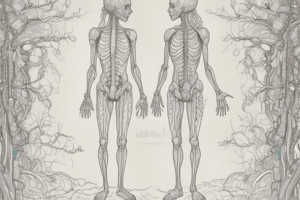Podcast
Questions and Answers
What are the two main divisions of the nervous system?
What are the two main divisions of the nervous system?
- Central and peripheral (correct)
- Sensory and motor
- Brain and spinal cord
- Autonomic and somatic
What is the purpose of assessing mental status in a nervous system assessment?
What is the purpose of assessing mental status in a nervous system assessment?
- To elicit muscle stretch reflexes
- To assess motor strength
- To test cranial nerves
- To evaluate cognitive function and consciousness (correct)
What is the primary function of cranial nerves?
What is the primary function of cranial nerves?
- To transmit sensory information from the face and head (correct)
- To facilitate communication between the brain and spinal cord
- To control voluntary muscle movements
- To regulate autonomic functions, such as heart rate and blood pressure
What is the primary difference between Wernicke aphasia and Broca aphasia?
What is the primary difference between Wernicke aphasia and Broca aphasia?
What is the primary concern with a patient who presents with fever, night sweats, and weight loss in addition to a headache?
What is the primary concern with a patient who presents with fever, night sweats, and weight loss in addition to a headache?
What is the purpose of grading muscle strength in a nervous system assessment?
What is the purpose of grading muscle strength in a nervous system assessment?
What is the primary purpose of assessing position sense in a nervous system assessment?
What is the primary purpose of assessing position sense in a nervous system assessment?
What is the primary difference between primary and secondary headaches?
What is the primary difference between primary and secondary headaches?
What is the likely nature of the patient's headache?
What is the likely nature of the patient's headache?
What is the likely cause of the patient's speech disorder?
What is the likely cause of the patient's speech disorder?
What is a characteristic of Broca aphasia?
What is a characteristic of Broca aphasia?
What is the leading risk factor for both ischemic and hemorrhagic stroke?
What is the leading risk factor for both ischemic and hemorrhagic stroke?
What is the risk of death from stroke within the next 12 months for patients with transient ischemic attacks (TIAs) that resolve within 1 hour?
What is the risk of death from stroke within the next 12 months for patients with transient ischemic attacks (TIAs) that resolve within 1 hour?
What is a benefit of public awareness campaigns for stroke recognition?
What is a benefit of public awareness campaigns for stroke recognition?
What is the significance of the patient's recent head trauma in relation to the headache?
What is the significance of the patient's recent head trauma in relation to the headache?
What is the characteristic of the patient's speech disorder that is not affected?
What is the characteristic of the patient's speech disorder that is not affected?
What is the consequence of not recognizing the signs of acute stroke?
What is the consequence of not recognizing the signs of acute stroke?
What is a characteristic of global aphasia?
What is a characteristic of global aphasia?
Flashcards are hidden until you start studying
Study Notes
Nervous System Fundamentals
- Two important questions to consider in nervous system disorders: localization of the responsible lesion(s) and underlying pathophysiology
- Nervous system divided into:
- Central Nervous System (CNS): brain and spinal cord
- Peripheral Nervous System (PNS): 12 pairs of cranial nerves and spinal and peripheral nerves, containing both motor and sensory fibers
Cranial Nerves
- Cranial nerves: 12 pairs, including sensory and motor fibers
Nervous System Assessment
- Assess mental status, cranial nerves, motor system, coordination, position sense, and sensory system
- Test muscle strength and elicit muscle stretch reflexes
- Use Reflex Grading Scale to assess reflexes
Cerebrovascular Disease
- Important to assess for cerebrovascular disease, including primary and secondary headaches
Headaches Assessment
- Key symptoms to prompt immediate investigation:
- Concomitant fever, night sweats, and weight loss
- Benign symptoms:
- Headache similar in nature to prior ones
- Headache comes and goes
- Losing glasses causing squinting and headache
Speech Disorders
- Wernicke Aphasia:
- Characterized by receptive and expressive aphasia
- Usually due to a lesion in the posterior superior temporal lobe
- Broca Aphasia:
- Characterized by expressive aphasia with sparing of language interpretation
- Usually due to a lesion in the posterior inferior frontal lobe
Stroke Recognition
- Risk factors for ischemic stroke:
- Atrial fibrillation
- Hypertension
- Obesity with normal glucose tolerance
- Transient ischemic attacks (TIAs) that resolve within 1 hour confer a 5% risk of death from stroke within the next 12 months
- Importance of rapid recognition and public awareness in suspected strokes
Studying That Suits You
Use AI to generate personalized quizzes and flashcards to suit your learning preferences.



